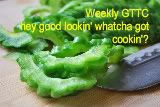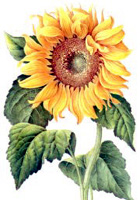This is a gigantic Chinese jade squash, sitting on top of a trellis in my father's garden. It has a while to go before it lightens in color and develops lovely green speckles/streaks. He's grown this squash for the past few years and loves the tender, mild taste. Later, he'll grate the pale yellow flesh and make fried squash patties or may finely chop the squash and combine it with minced shrimp and ground pork to make his famous dumplings.
Prior to these past few years though, my father had not tasted this squash since probably the early 1960's. Shortly after that time, my father made his way from rural China to bustling Hong Kong, then finally to the suburbs of the United States where he cultivated several different gardens in the backyards of several different homes. He tried for the first time, and then subsequently grew many vegetables that a typical American gardener would grow such as tomatoes, cucumbers and summer squash.
While my father was gardening in the United States, gardeners in Shandong, China, remained guardians of this very local heirloom squash, growing them season after season, saving seeds season after season so that one day, decades later, my father would meet an old friend with a handful of seeds to share. These seeds were saved from my father's favorite squash grown back home during his childhood decades ago. While my father may now be accustomed to tasting Chinese jade squash every fall since he's been saving seeds for a few years now, I am amazed every time I see this gorgeous thing up on the trellis from a very far off place and time.
(cross-posted at The Chinese Kitchen Garden blog - please visit this blog to learn more about growing and cooking Asian vegetables!)






.jpg)
.jpg)





























.jpg)
.jpg)
.jpg)
.jpg)
.jpg)
.jpg)
.jpg)
.jpg)

.jpg)
.jpg)
.jpg)
.jpg)
.jpg)

.jpg)

.jpg)



















